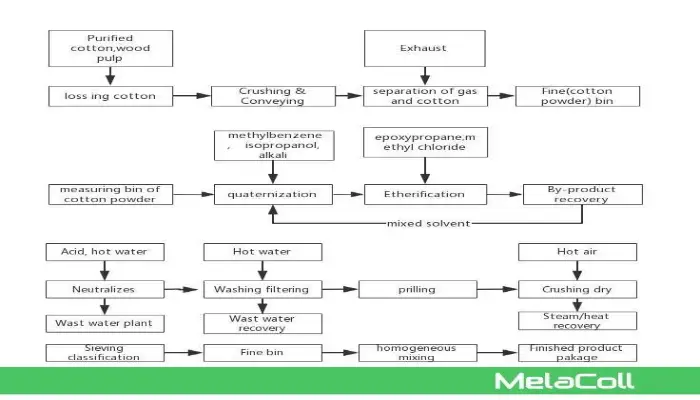
1. Mikä on nestemäisen faasin tuotantomenetelmä?
HPMC:n nestemäisen faasin tuotantomenetelmä (lietteen valmistusmenetelmä) edellyttää asetonin, isopropanolin, tert-butanolin, tolueenin, 1,2-metoksietaanin tai heikkolaatuisten hiilivetyjen ja pienen määrän heikkolaatuisia alkoholeja sekoitettua järjestelmää liuottimena (tai dispergointiaineena), jotta selluloosa saadaan sekoittumaan täydellisesti emäksisen aineen kanssa, metyylikloridi, propyleenioksidi ja vastaavat lietejärjestelmässä, kuten nestemäisessä lietetilassa, selluloosan alkalointi- ja eetteröintireaktion loppuun saattamiseksi. Tämä tuotantomenetelmä edellyttää puu- ja puuvillaselluloosan raaka-aineiden murskaamista etukäteen.
MelaColl™ HPMC:n nestemäisen vaiheen tuotantomenetelmän erityinen toimintaprosessi perustuu tuotteen suorituskyky- ja indeksivaatimuksiin. Tuottaja voi ottaa käyttöön alkalointimenetelmä → eetteröinti tai hyväksyä peräkkäinen alkalointi → eetteröinti → sekundaarinen alkalointi → sekundaarinen eetteröinti monivaiheinen menetelmä lopputuotteen saamiseksi, jolla on parempi tasalaatuisuus ja korkeampi substituutioaste.
Erityinen HPMC:n tuotantoprosessi: Tuottaja voi järjestää murskatun selluloosan hienojakoisen jauheen pystysuorassa tai vaakasuorassa reaktorissa, jossa on voimakas sekoituslaite, joka on dispergoitu liuottimeen, sitten tietty määrä emäksistä nestettä, propyleenioksidia ja metyylikloridia lisätään eetteröintiä ja reaktiota varten. Reaktion päätyttyä lopputuote saadaan kuumavesipesun, kuivauksen, murskauksen ja seulonnan avulla.
Tuotantomenetelmän vuokaavio on esitetty seuraavassa kuvassa:
Nestemäisen vaiheen tuotantomenetelmän päälaitteet:
| Kohde | Kulutuskiintiö | Kohde | Kulutuskiintiö | ||
| Raaka-aineet | Selluloosa/T | 0.84-0.88 | Raaka-aine | Tolueenin ja isopropanolin seosliuotin/t | 0.07-0.10 |
| 50% Emäksinen neste/T | 0.86-1.00 | Teho | Vesi/t | 50.00-60.00 | |
| Metyylikloridi/T | 0.57-0.70 | Sähkö/kWh | 3000-3500 | ||
| Propyleenioksidi/T | 0.19-0.21 | Höyry/t | 8.00-9.00 | ||
Tuotantomenetelmässä käytetään dispergointiaineina tolueenin ja isopropanolin sekoittuneempia liuottimia. Tuotantomenetelmässä käytetty pääasiallinen reaktiopaine on alle 1MPa. Kun reaktio on saatu päätökseen, seosliuotin, joka on peräisin tolueeni ja isopropanoli otetaan talteen.
Tuotantotekniikka mahdollistaa polyvinyylikloridilaadun (PVC) tuotannon, rakennus-, lääke- ja elintarvikekäyttöön tarkoitetut HPMC-tuotteet..
2. Nestemäisen tuotantomenetelmän edut ja puutteet
Nestefaasimenetelmällä on seuraavat edut: Reaktiolaitteiston sisäinen paine on pieni, laitteiston painevaatimus on alhainen ja vaara on minimaalinen. Kun selluloosa on kyllästetty emäksiseen liuokseen, selluloosa on täysin paisunut, ja emäksinen selluloosa ja emäksinen neste voivat tasaisesti alkalisoitua, jolloin selluloosan soluttautuminen ja turvotus paranevat. Eetteröintireaktori on pieni, ja emäksinen selluloosa turpoaa tasaisesti, minkä ansiosta tuottaja voi helposti valvoa tuotteen laatua ja saada aikaan paremman tasalaatuisuuden substituutioasteen ja viskositeetin suhteen. Lisäksi tuottaja voi helposti muuttaa haluttua tuotelajiketta.
Nestefaasituotantomenetelmällä on kuitenkin myös seuraavat puutteet: Reaktori ei yleensä ole liian suuri (alle 15 m).3), ja kapasiteetti on pieni tilastollisten rajoitusten vuoksi. Tuotannon lisäämiseksi on pakko lisätä useampi kuin yksi reaktori. Raakatuotteiden jalostus ja puhdistus vaativat paljon laitteita, monimutkaisia toimintoja ja paljon työvoimaa. Koska muotinesto- tai sekoituskäsittelyä ei suoriteta, tuotteen viskositeettistabiilisuus ja tuotantokustannukset kärsivät. Kun tuottaja ottaa käyttöön tämän manuaalisen pakkausmenetelmän, työvoiman intensiteetti ja kustannukset kallistuvat.
Reaktioiden hallinnan automaatioaste on nestemäisessä tuotantomenetelmässä alhaisempi kuin kaasufaasituotantomenetelmässä, joten hallinnan tarkkuus on alhaisempi. Toisin kuin kaasufaasituotantomenetelmässä, nestefaasituotantomenetelmässä tarvitaan monimutkainen liuottimen talteenottojärjestelmä. Tällä hetkellä kehitetään jatkuvasti uusia tuotantotekniikoita, ja myös hydroksipropyylimetyylin kaavaa parannetaan jatkuvasti eri alojen tuotteiden erityistarpeiden täyttämiseksi. Lisäksi hpmc:n lisäksi kehitetään jatkuvasti uusia sekoitettuja eettereitä.


Jätä vastaus